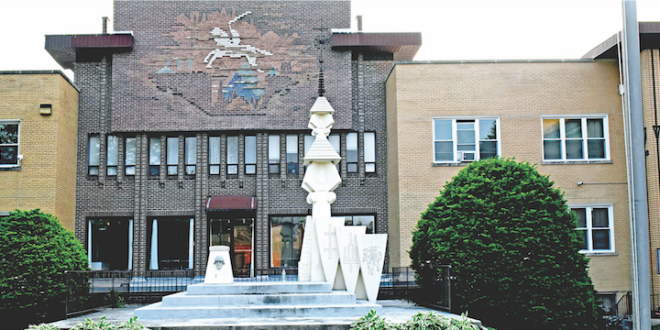On May 23, the Lithuanian Jesuit Fathers signed over ownership of the Lithuanian Youth Center to Chicago’s Lithuanian community. The center is a large complex located in Chicago’s Gage Park neighborhood. It has been the epicenter of Lithuanian cultural activity for over a half-century. The new owner, Lithuanian Center, Inc., represents the Chicago Lithuanian community, which has been administering and managing much of the property for the last decade.
The news was positively received by Chicago Lithuanians. This transfer marked a historic moment, as it was a rare instance of a religious organization returning an asset to the community, which funded and enabled its operation.
Vida Kuprys.
The Lithuanian Youth Center of Chicago (also known as “JayCees” – the initials of its Lithuanian name, “Jaunimo centras”) was established on October 6, 1957, through the initiative of the Lithuanian Jesuits. A fundraising committee was formed, which included Bishop Vincentas Brizgys, Lithuanian General Consul in Chicago Petras Daužvardis, pastors of local Lithuanian parishes and leaders of some 20 Lithuanian organizations. The Center was built in stages from 1956 to 1975. It encompassed a large auditorium, classrooms, an art gallery, a cafe, a chapel and a Jesuit residence. Until recently, it was also the principal repository of the Lithuanian Research Center (LRC). (The Center still houses the LRC’s library and exhibits, but its archives were moved to a newly acquired building in Lemont, Illinois.)
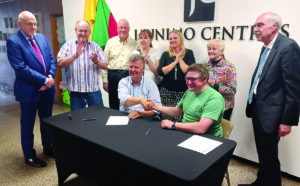
The Youth Center features many Lithuanian motifs. The building’s facade includes the Lithuanian knight (Vytis), constructed of brick and designed by architect Jonas Mulokas. A stylized wayside chapel, built as a memorial to those who sacrificed their lives for Lithuania’s freedom, is a central feature of the Center’s courtyard.
Over time as the number of Lithuanian Jesuits decreased in Chicago, local Lithuanians established a not-for-profit corporation, Lithuanian Center, Inc., as an auxiliary supporting organization to manage and help operate the Youth Center. It took charge of most of the complex, except for the chapel and monastery. Presently the Center houses a thriving Lithuanian heritage Saturday school and organizes numerous art exhibits and cultural programs. Lithuanian Center, Inc. also initiated innovative fundraising events to cover operating expenses.
Currently, there is only a single Lithuanian Jesuit, Father Vaidas Lukoševičius, SJ, who works in the Chicago metropolitan area. He serves the Lithuanian community at the Blessed Jurgis Matulaitis Mission in suburban Lemont and resides there. Thus the Youth Center monastery stands vacant, and its utilities have been shut off. This situation raised concerns among the Lithuanian community about the property’s prospective future: will it be sold? Are we at risk of losing another significant institution funded by our community? Adding to the unease was the reorganization of the Lithuanian Jesuits, who recently became a part of the newly created Central European Province. Will this new entity understand the concerns of Chicago Lithuanians?
A sigh of relief

After several years of meetings and negotiations, the Lithuanian Center, Inc. received an offer from the Jesuits. The Jesuits were willing to transfer ownership of the entire complex to the Lithuanian Center, Inc., but with certain conditions if the Center was sold during the next 50 years.
Antanas Rašymas, president of the Lithuanian Center, Inc., had the Center’s attorney Vytenis Lietuvninkas review the legal implications and related a portion of their discussion. “He explained: if we don’t sell the building, we can continue to operate it in the usual manner. If we sell, the contract stipulates how to settle up with the Jesuits. But we are not even considering the sale of the building because, in the opinion of our Board, Lithuanians in Chicago need the Youth Center.” Rašymas further quoted the Center’s attorney, “Lietuvninkas told us, ‘This isn’t a big deal, it’s a huge deal!’” expressing relief and amazement that the Center will not go the way of many other Lithuanian faith-based institutions – churches, nursing homes, cemeteries – funded by the generous donations of the Lithuanian faithful, only to be sold or demolished without any benefit to them.
Recognition of the donors’ intent
Representatives from the Jesuit Fathers and the Lithuanian Center board met on May 23 at the Youth Center to finalize the transfer. Father Vaidas Lukoševičius, SJ, and Antanas Rašymas signed the agreement. This historic event was witnessed by board members of the Lithuanian Center, Inc. Robert Vitas, Jonas Žiūraitis, Viktorija Černičenko, Daiva Petersonas, Nelia Paulauskas and Andrius Račkauskas, as well as representatives from the Jesuit Province and the attorneys of both parties – Al Domanskis and Vytenis Lietuvninkas.
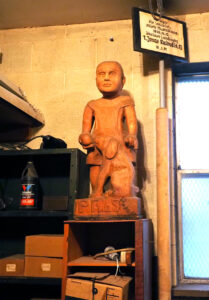
The participants gathered in the Center’s cafe for celebratory champagne and refreshments. Father Vidmantas Šimkūnas, SJ, on behalf of the Jesuits, noted: “These buildings – the monastery, the center and the chapel – do not belong to the Jesuits… All this was entrusted to the Jesuits to use and serve the people, educate the youth, and help them find God and purpose in their lives. We have done that work, and we will continue to do so. We wish that you, too, do the same.”
Central European Jesuit Province economist Martin Tanzer explained the Jesuits’ rationale for granting the Center to Lithuanians. “Firstly, the funds collected in the past were intended for the Lithuanian community here. The second reason is that the Jesuits have no capacity to work here themselves, so it is best to give it to those responsible for the Lithuanian community and those who continue to support the Jesuits’ work.”
Like all religious orders, the Jesuits suffer from the “The harvest is plentiful, but the laborers are few” syndrome. They continue to rely on the support of Lithuanian Americans and need to foster goodwill. Tanzer continued, “What is the advantage for the Jesuits if they have a building but no Jesuits working there? That makes no sense. So I think it was the right decision. It was not an easy decision. We hope that the community here will also support the Jesuit institutions in Lithuania because we also need funds to operate the Jesuit schools in Kaunas and Šiauliai. We face great challenges there, and we need to focus our resources there. And I hope that the Lithuanians here will help us.”
Has the dog caught the bus?
Rašymas emphasized the need to take swift action now that the keys have been handed over. “It’s time to roll up our sleeves and get to work,” he said. The first task is calling in a team of specialists to estimate the cost of needed repair work. Rašymas could not specify how many rooms there were in the three-story monastery. There may be 15 per floor. Some of the rooms were, until recently, utilized by the Lithuanian school and are in fair condition, but others were vacant for years. Paint is peeling, plaster is falling, and there is a distinct scent of mildew. Rašymas noted the Center would have to repair the flat roof and walls of the building. Plumbing is another concern. Thus making the monastery premises habitable will require substantial time and funds.
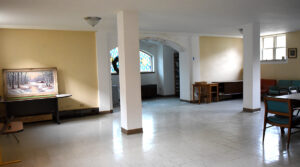
Then there is the issue of how to utilize the excess space. Rašymas suggested that some rooms could be assigned for use by visiting scholars and students, locally and from Lithuania. Other rooms could be used to store the archives of Lithuanian organizations. They could be designated as art studios. There is also the possibility the rooms could be used for senior housing.
The president of Lithuanian Center, Inc. said he would consider any and all suggestions. The challenges loom large, but for now, the excitement and enthusiasm appear to be larger and bode well for the Center’s future.
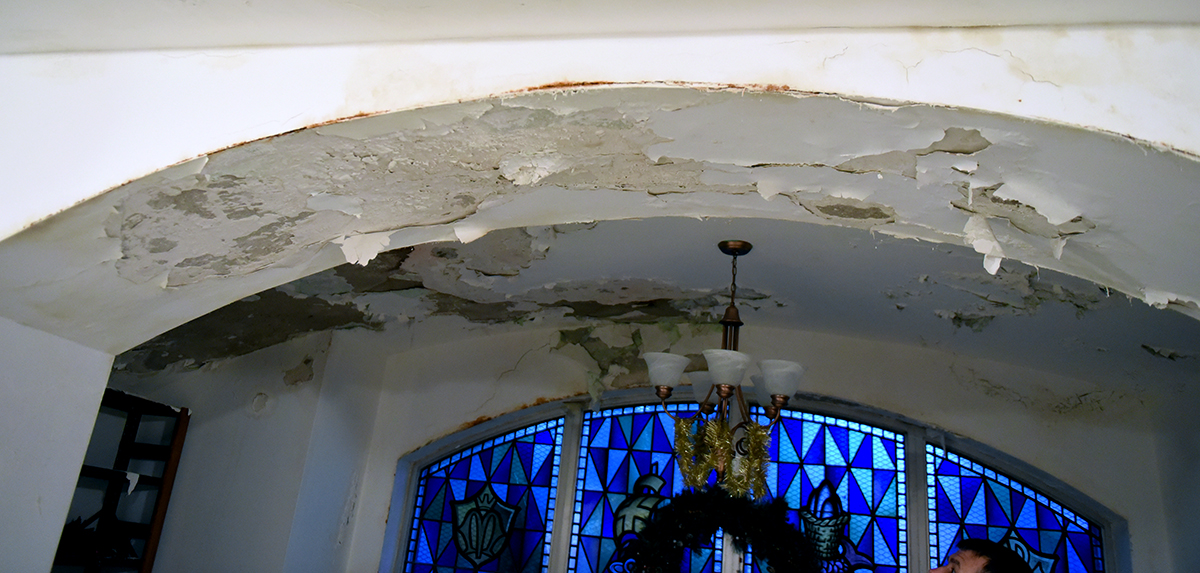
 DRAUGAS NEWS Lithuanian World Wide News in English
DRAUGAS NEWS Lithuanian World Wide News in English
